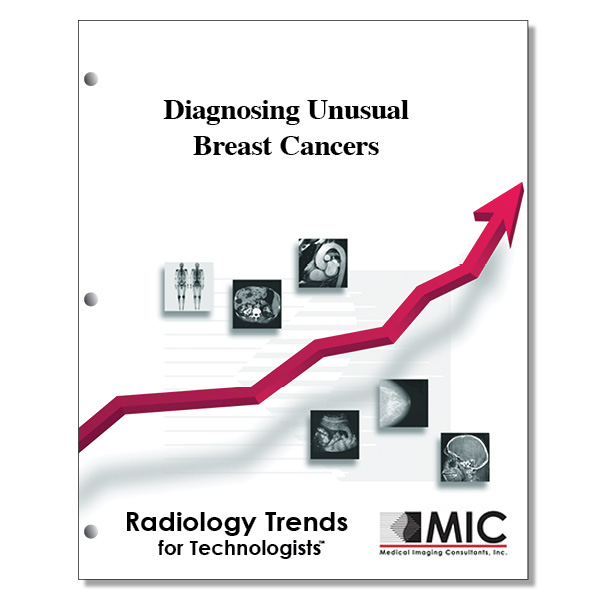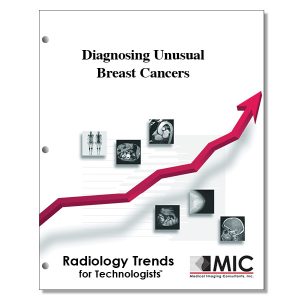

Diagnosing Unusual Breast Cancers
A presentation of unusual breast neoplasms and other types of malignant neoplasms of the breast.
Course ID: Q00198 Category: Radiology Trends for Technologists Modalities: Mammography, Nuclear Medicine2.0 |
Satisfaction Guarantee |
$24.00
- Targeted CE
- Outline
- Objectives
Targeted CE per ARRT’s Discipline, Category, and Subcategory classification for enrollments starting after May 25, 2023:
Breast Sonography: 2.00
Patient Care: 0.75
Patient Interactions and Management: 0.75
Image Production: 0.50
Evaluation and Selection of Representative Images: 0.50
Procedures: 0.75
Anatomy and Physiology: 0.25
Pathology: 0.25
Breast Interventions: 0.25
Mammography: 2.00
Patient Care: 0.75
Patient Interactions and Management: 0.75
Procedures: 1.25
Anatomy, Physiology, and Pathology: 1.00
Mammographic Positioning, Special Needs, and Imaging Procedures: 0.25
Magnetic Resonance Imaging: 2.00
Patient Care: 0.50
Patient Interactions and Management: 0.50
Procedures: 1.50
Body: 1.50
Nuclear Medicine Technology: 2.00
Patient Care: 0.50
Patient Interactions and Management: 0.50
Procedures: 1.50
Endocrine and Oncology Procedures: 1.50
Registered Radiologist Assistant: 2.00
Procedures: 2.00
Thoracic Section: 2.00
Sonography: 2.00
Patient Care: 0.50
Patient Interactions and Management: 0.50
Procedures: 1.50
Superficial Structures and Other Sonographic Procedures: 1.50
Radiation Therapy: 2.00
Patient Care: 1.00
Patient and Medical Record Management: 1.00
Procedures: 1.00
Treatment Sites and Tumors: 1.00
Outline
- Introduction
- Invasive Lobular Carcinoma
- Subtypes of Ductal Carcinoma
- Tubular Carcinoma
- Mucinous Carcinoma
- Medullary Carcinoma
- Papillary Carcinoma
- Malignant Neoplasms of Stromal Origin
- Phyllodes Tumor
- Angiosarcoma
- Osteosarcoma
- Adenoid Cystic Carcinoma
- Metastatic Lesions
- Non-Hodgkin Lymphoma
- Metastatic Melanoma
- Metastatic Carcinoma
- Rhabdomyosarcoma and Leukemia
- Summary
Objectives
Upon completion of this course, students will:
- learn the percentage of breast cancers from IDC and DCIS
- recognize the clinical findings of ILC
- realize the most common treatment for ILC
- understand the appearance of ILC
- identify the most common type of ductal breast cancer
- know the survival rate of tubular carcinoma
- identify one kind of circumscribed breast cancer
- know what carcinoma has a semisolid substance
- describe the margins of circumscribed cancers
- know the appearance of medullary carcinomas
- recognize the carcinoma that manifests as an intraductal or intracystic mass
- learn which carcinoma is the most benign intraductal mass
- learn what phyllodes tumors manifest as
- recognize the mammographic appearance of phyllodes tumors
- know what phyllodes tumors look like on a screening mammogram
- learn the location of phyllodes tumors metastases
- learn where angiosarcoma occurs
- know what angiosarcomas manifest as
- realize that angiosarcomas appear after radiation therapy
- learn when osteosarcoma is more common
- identify the location of osteosarcoma metastases
- recognize where adenoid cystic carcinoma arises
- understand the rate at which adenoid cystic carcinoma grows
- name one of the most common metastatic lesions in the breast
- learn which type of lesion is characterized by bilateral axillary adenopathy
- learn which type of lesion is characterized by unilateral adenopathy or enlargement of an intramammary lymph node
- know a clinical sign of metastatic carcinoma
- learn which type of breast cancer is extremely rare
- identify the location of ILC metastases
- recognize which type of cancer has a very large, circumscribed breast mass
